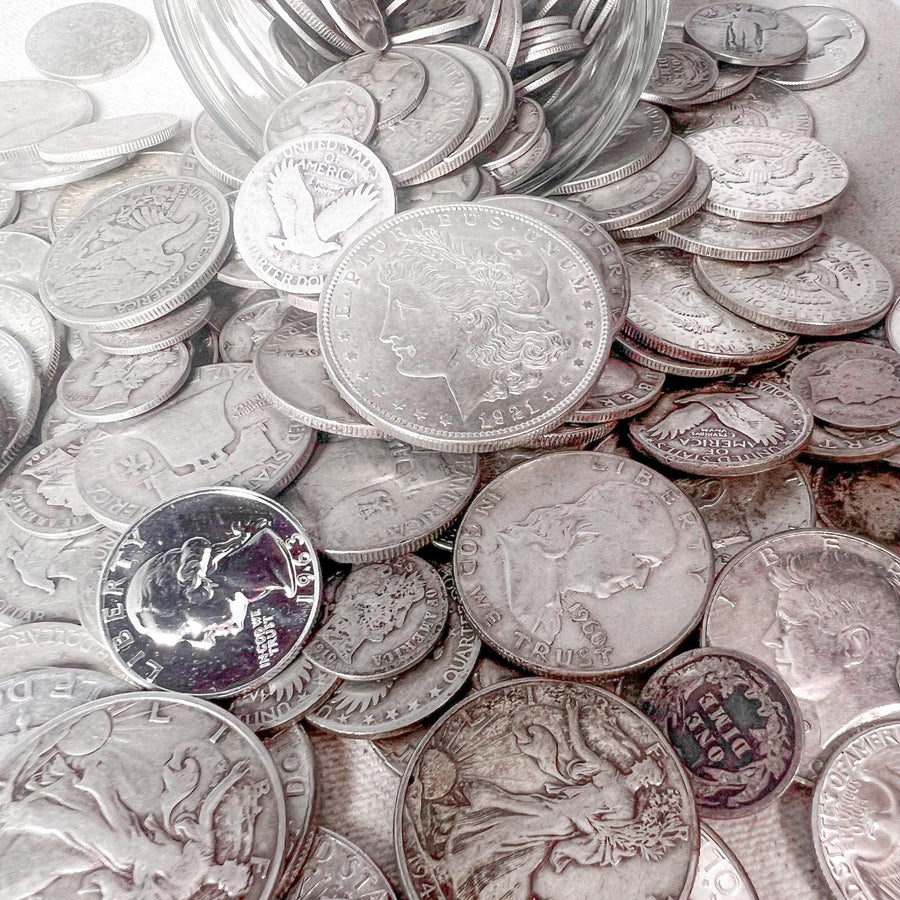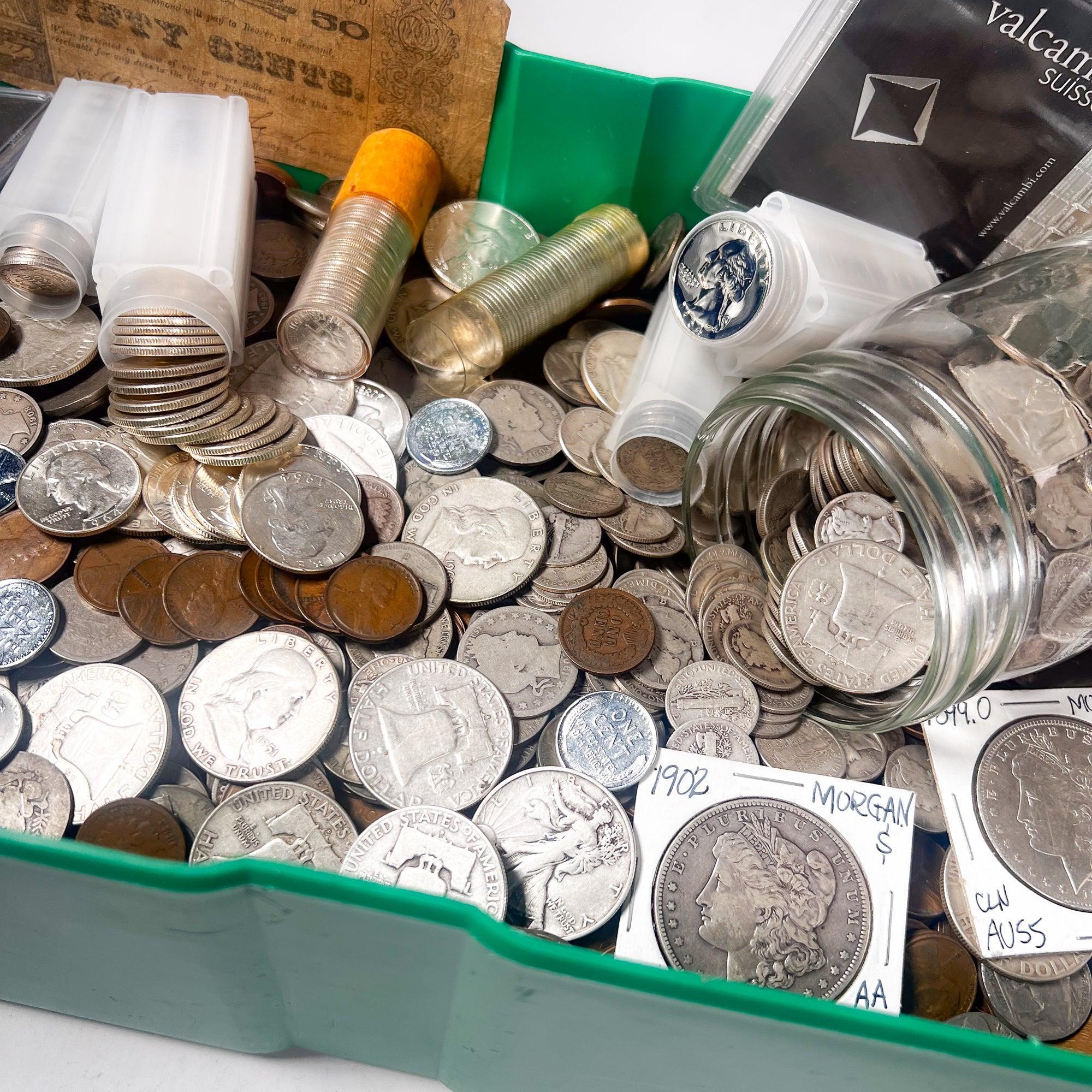The Enduring Appeal of Collecting Morgan Silver Dollars: A Guide for Investors and Enthusiasts
For the discerning collector and investor, few tangible assets encapsulate the rich tapestry of American history and the enduring allure of precious metals quite like the Morgan Silver Dollar.
These iconic coins, struck during a pivotal era of the United States, represent not merely currency, but a profound narrative of economic expansion, political discourse, and artistic achievement. For individuals seeking to acquire authentic, high-quality vintage U.S. coins, the journey into collecting Morgan Silver Dollars offers both immense satisfaction and potential for significant portfolio enhancement.
This pursuit is often shadowed by the pervasive concern of counterfeit items and the challenge of identifying reputable sources.
This comprehensive guide aims to illuminate the path for serious collectors, delving into the historical significance, intricate characteristics, and crucial authentication aspects of these cherished numismatic treasures, thereby establishing the foundation for confident and informed acquisition.
The Enduring Appeal of the Morgan Silver Dollar
The Morgan Silver Dollar stands as a cornerstone in U.S. numismatics. Its intricate design and compelling history resonate deeply with collectors and investors across generations. Its legacy is not just etched in silver, but woven into the very fabric of American development.
A Legacy Forged in Silver
The Morgan Dollar's historical and cultural significance in U.S. numismatics is profound. It emerged during a transformative period in American history, bridging the post-Civil War era with the burgeoning industrial age. Each coin is a tangible piece of this past, representing the nation's economic vigor and westward expansion. Its design, a departure from previous coinage, captured the spirit of a nation striving for a distinct identity, making it a powerful emblem of American ingenuity and artistic expression.
Why Collect Morgan Dollars?
The motivations for collecting Morgan Silver Dollars are multifaceted. They appeal to a broad spectrum of individuals, from dedicated numismatists to strategic investors seeking portfolio diversification.
Intrinsic Silver Content as a Tangible Asset
At their core, Morgan Dollars possess a robust intrinsic value, comprised of 90% silver and 10% copper. This substantial silver content imbues them with the inherent appeal of a tangible asset. This provides a hedge against economic volatility and a reliable store of wealth. In an era of fluctuating paper currencies, the physical presence of precious metals offers a sense of security and permanence.
Historical Narrative as a Window into American History
Beyond their metallic composition, Morgan Dollars serve as miniature chronicles of American history. Each coin tells a story of the American West, the rise of silver mining, and the political battles that shaped the nation's monetary policy. U.S. silver coin collecting, particularly focusing on the Morgan Dollar, allows enthusiasts to engage directly with these historical narratives, holding a piece of the past in their hands.
Appeal to Both Serious Numismatists and Investors
The broad appeal of Morgan Dollars extends equally to serious numismatists who appreciate their artistic merit, die varieties, and historical context. Investors also recognize their potential for appreciation as both tangible assets and sought-after collectibles. Their dual nature makes them uniquely attractive for investment diversification, offering a blend of commodity value and numismatic premium.
Navigating Authenticity and Value
For any collector, navigating the market for U.S. silver coin collecting presents a critical challenge: ensuring authenticity and accurately assessing value. The proliferation of counterfeit items necessitates a keen eye, expert knowledge, and a steadfast commitment to sourcing from reputable channels. This article will equip collectors with the insights needed to confidently identify genuine pieces, understand the nuances of Morgan dollar values, and protect their investments against fraudulent offerings. It ultimately underscores the indispensable role of a trusted partner in this journey.
Historical Context: The Birth of an American Icon
The genesis of the Morgan Silver Dollar is deeply intertwined with the economic and political landscape of post-Civil War America. This was a period of immense change and strategic monetary decisions.
Post-Civil War Economic Landscape
Following the conclusion of the Civil War, the United States embarked on a period of reconstruction and rapid industrialization. The nation's monetary system, however, was in flux. The demonetization of silver in 1873, often referred to as the "Crime of '73," removed silver from its bimetallic standard alongside gold, leading to significant political and economic debate, particularly from the silver mining states.
The Bland-Allison Act of 1878
The political response to the demonetization of silver culminated in the Bland-Allison Act of 1878. This congressional mandate compelled the U.S. Treasury to purchase between two and four million dollars' worth of silver each month at market price and to coin it into silver dollars. This act effectively brought the silver dollar back into widespread production, setting the stage for the creation of the Morgan Dollar.
Influence of the Comstock Lode and Silver Mining Interests
The Bland-Allison Act was heavily influenced by powerful silver mining interests, particularly those in the American West. The discovery of the Comstock Lode in Nevada in 1859 had led to an unprecedented boom in silver production. This created immense pressure to find an outlet for this abundant metal. The Act served as a crucial economic lifeline for these mining operations, ensuring consistent demand for their output.
Political and Economic Forces Driving U.S. Mint Production
The political landscape was divided between "silverites" who advocated for a bimetallic standard to inflate the currency and aid debtors, and "gold bugs" who favored a strict gold standard. The Bland-Allison Act represented a compromise. It firmly reinstated the silver dollar as a circulating medium, thus driving the U.S. Mint to commission a new design for this critical coinage.
George T. Morgan: The Designer's Vision
The task of designing this new silver dollar fell to George T. Morgan, an English engraver who had been recruited to the U.S. Mint. His artistic vision would redefine American coinage and create an enduring numismatic legacy.
Departure from the Seated Liberty Design
Prior to the Morgan Dollar, U.S. silver coinage, including the silver dollar, largely featured the Seated Liberty design, created by Christian Gobrecht. Morgan's design marked a distinct departure from this classical European-inspired motif. He aimed for a more distinctly American interpretation of liberty.
Artistic Interpretation and Symbolism of Lady Liberty and the American Eagle
Morgan's design for the obverse features a profile of Lady Liberty, modeled by Anna Willess Williams, a Philadelphia schoolteacher. Her depiction is characterized by a classical, yet strong and distinctly American, profile adorned with a Phrygian cap and cotton and wheat intertwined in her hair, symbolizing America's agricultural roots and aspirations. The reverse features a majestic American Eagle with outstretched wings, clutching an olive branch (peace) and arrows (readiness for war). It is encircled by "UNITED STATES OF AMERICA," "IN GOD WE TRUST," and "ONE DOLLAR." This rich symbolism conveyed national ideals and strength.
Morgan's Design Legacy within the U.S. Mint
George T. Morgan's design proved immensely popular and resilient, solidifying his reputation within the U.S. Mint. His work on the silver dollar cemented his place as one of America's most influential coin designers, creating a design that would outlast many of his contemporaries.
Production Era: 1878-1904 and 1921
Morgan Dollars were produced continuously from 1878 to 1904. Production ceased when the government's silver reserves, mandated by the Bland-Allison Act and subsequent Sherman Silver Purchase Act, were depleted. However, a final mintage occurred in 1921. This was spurred by the Pittman Act of 1918 which authorized the melting and recoinage of millions of silver dollars. The 1921 issues often possess a distinct character, minted at the Denver Mint for the first time, alongside Philadelphia and San Francisco, before the introduction of the Peace Dollar later that year. This interrupted production history adds another layer of intrigue for those collecting Morgan Silver Dollars.
Identifying Authentic Morgan Dollars: Key Characteristics and Varieties
For any collector, understanding the fundamental characteristics and subtle varieties of Morgan Silver Dollars is paramount. This knowledge forms the bedrock for discerning authentic Morgan dollars from forgeries and accurately assessing their Morgan dollar values.
Design Elements and Specifications
The consistency in design and physical properties across all genuine Morgan Dollars provides the first line of defense against counterfeits.
Obverse (Front): Lady Liberty's Profile
The obverse of the Morgan Dollar prominently features a left-facing profile of Lady Liberty. Above her head, the national motto "E PLURIBUS UNUM" is inscribed, with the date of mintage below her neck. Encircling her image are 13 stars, symbolizing the original thirteen colonies. Collectors should meticulously examine the clarity of these elements, the crispness of Liberty's hair, and the distinct separation of the stars. Inconsistent spacing, blurry details, or misshapen elements can be indicators of a non-genuine coin.
Reverse (Back): American Eagle with Outstretched Wings
The reverse displays a majestic American Eagle, its wings outstretched, clutching an olive branch and arrows. Above the eagle, "UNITED STATES OF AMERICA" is inscribed, with "ONE DOLLAR" below. The motto "IN GOD WE TRUST" is gracefully positioned between the eagle's wings. The intricacy of the eagle's feathers, the clarity of the inscriptions, and the precise details of the olive branch and arrows are critical authentication points. Weak strikes or blurred features in these areas often suggest a counterfeit or a poorly produced replica.
Physical Characteristics of Morgan Dollars
Every genuine Morgan Dollar adheres to precise physical specifications that are difficult for counterfeiters to perfectly replicate.
- Composition: Coins are 90% silver and 10% copper, providing a specific luster and density.
- Weight: Each coin weighs 26.73 grams. Slight deviations can indicate a counterfeit.
- Diameter: The standard diameter is 38.1 millimeters. Any significant variance warrants suspicion.
- Reed Edge: The edge features precisely spaced reeds, which should be sharp, uniform, and consistent. Irregular reeding is a common sign of a fake.
Mint Marks: Tracing Provenance and Rarity
Mint marks are crucial identifiers that denote where a coin was struck and significantly influence its rarity and Morgan dollar values.
Location of the Mint Mark
The mint mark on a Morgan Dollar is consistently located on the reverse of the coin, directly below the eagle, just above the "O" in "ONE DOLLAR." Its presence, absence, and specific letter are vital for identification.
Key U.S. Mint Facilities
Understanding the specific mint marks and their corresponding facilities is essential for anyone collecting Morgan Silver Dollars.
- "CC" – Carson City: Legendary for rarity and collector appeal due to short operational period and lower production.
- "S" – San Francisco: Produced a substantial number, often noted for strong strikes and appealing luster.
- "O" – New Orleans: Generally more common, though specific dates can carry significant premiums.
- "D" – Denver (only 1921): Exclusive to 1921, making the "D" mint mark distinct.
- No Mark or "P" – Philadelphia: Coins struck at the primary U.S. Mint bear no mint mark or a small "P" in later instances.
Significance of Mint Marks for Value
The presence or absence of a mint mark, coupled with the specific year of mintage, fundamentally impacts Morgan dollar values. A Carson City (CC) dollar from almost any year will command a significantly higher price than a Philadelphia (P) or New Orleans (O) dollar of the same year, assuming similar condition. This distinct rarity drives intense collector demand and is a primary factor in numismatics.
Varieties and Anomalies: The Nuances of Production
Beyond standard mint marks, the production process itself often introduced subtle variations and anomalies that are intensely studied by advanced collectors.
VAM Varieties (Van Allen-Mallis)
The extensive cataloging system known as VAM varieties, short for Van Allen-Mallis, meticulously documents thousands of die varieties found on Morgan Dollars. These variations occur due to specific characteristics of the dies used to strike the coins, such as die cracks, repunched dates, or errors in die preparation. For advanced U.S. silver coin collecting enthusiasts, identifying VAM varieties adds an intricate layer to the hobby, offering a specialized pursuit within the broader field. Many VAMs can significantly increase Morgan dollar values. Well-known examples include the "Hot Lips" (1888-O) with a doubled upper lip, and various "Doubled Dies" where parts of the design appear duplicated.
Identifying Design Variations and Their Impact on Collectibility
The ability to identify these subtle design variations requires detailed knowledge and often magnification. While some variations are minor, others can drastically affect a coin's collectibility and value. Such detailed expertise is a hallmark of truly authentic Morgan dollars and the deep study involved in advanced numismatics.
Grading and Authenticity: Ensuring the Value of Your Collection
For discerning collectors, ensuring the authenticity and accurately assessing the condition of Morgan Dollars are paramount to safeguarding their investment. This is where the rigorous standards of professional coin grading and the vigilance against counterfeits become indispensable.
Understanding Coin Grading
Coin grading is the standardized process of evaluating a coin's condition, which directly influences its rarity and market value.
The Importance of Condition
The condition of a Morgan Dollar, encompassing its wear, luster, and strike quality, is arguably the single most critical factor in determining its Morgan dollar values. A coin in pristine, uncirculated condition will fetch significantly higher prices than a heavily worn counterpart, even if both are from the same year and mint. Every scratch, ding, or sign of friction reduces a coin's grade and, consequently, its market appeal.
The Sheldon Coin Grading Scale Terminology
The widely adopted Sheldon Coin Grading Scale ranges from Poor (P-1) to Perfect Mint State (MS-70). This granular scale provides a universal language for describing a coin's condition.
- About Uncirculated (AU): Coins showing only slight wear on highest points, retaining most original luster (AU-50 to AU-58).
- Uncirculated (UNC or MS): Coins with no signs of wear, retaining original mint luster, also called "Mint State" (MS-60 to MS-70).
- Proof (PR or PF): Specially struck collector coins, characterized by sharp details and mirrored fields, not for circulation. Understanding these terms is fundamental to comprehending coin grading reports and market pricing.
Professional Coin Grading Services (PCGS) and Numismatic Guaranty Corporation (NGC)
To mitigate the risk of acquiring counterfeit items and to establish an unbiased assessment of a coin's condition, collectors heavily rely on third-party grading services. Services like PCGS (Professional Coin Grading Service) and NGC (Numismatic Guaranty Corporation) are the industry's leading authorities. They employ expert numismatists to evaluate coins, assign a grade, and authenticate their legitimacy. This independent assessment provides unparalleled confidence for buyers and sellers.
Once graded, coins are sonically sealed in tamper-evident plastic holders, known as "slabs," which include a unique serial number and a detailed certification label. This encapsulation protects the coin from environmental damage and further handling, while the certification provides an immutable record of its authenticity and grade. For collectors, these services are vital in securing authentic Morgan dollars and validating their investment.
Assessing Authenticity: Beyond the Surface
While professional grading offers the ultimate assurance, understanding how to initially assess authenticity is crucial for any collector engaging in U.S. silver coin collecting.
Expert Examination
Identifying genuine U.S. silver coin collecting pieces requires a specialized eye. Expert examination involves scrutinizing every detail, comparing the coin against known authentic examples, and employing techniques that go beyond superficial inspection. This level of expertise comes from years of experience and deep knowledge of minting processes and known fakes.
Common Counterfeit Indicators
Collectors should be aware of common indicators that suggest a coin might be counterfeit.
- Inaccurate Weight or Diameter: Counterfeits often use cheaper alloys, leading to incorrect weight or dimensions.
- Poor Strike Quality and Fuzzy Details: Fake coins frequently exhibit weak or indistinct details in fine areas.
- Incorrect Mint Marks or Dates: Counterfeiters may alter existing mint marks or dates to create rarities.
- Atypical Sound (Ping Test): Genuine silver produces a distinct, resonant "ping." Counterfeits often produce a duller thud. (Exercise caution: this test can damage coins).
- Magnetic Properties: Genuine silver is non-magnetic. A strong magnet can reveal ferrous metals, indicating a counterfeit.
The Critical Role of Reputable Sources
The most effective way to protect oneself from counterfeits is to source coins exclusively from reputable dealers. A dealer committed to transparency, offering guarantees of authenticity, and providing coins already certified by PCGS or NGC, is indispensable for confidently acquiring authentic Morgan dollars. This approach addresses the challenge of finding trustworthy sources, emphasizing the importance of established expertise.
Key Dates, Conditional Rarities, and Investment Potential
Understanding what makes certain Morgan Dollars more valuable than others is crucial for smart collecting Morgan Silver Dollars.
Identifying "Key Dates" and "Semi-Key Dates"
"Key dates" are specific years and mint mark combinations that are inherently rare due to low mintage figures. Examples include the 1889-CC, 1893-S, and 1895 (Proof Only) Morgan Dollars. "Semi-key dates" are also low-mintage but generally more accessible than true key dates. These issues consistently command significant premiums regardless of condition, forming the backbone of any serious collection.
Understanding "Conditional Rarity"
Beyond mintage figures, "conditional rarity" plays a pivotal role in Morgan dollar values. A coin might be from a common mintage year (e.g., 1921-P), but if it exists in an exceptionally high, pristine Mint State grade (e.g., MS-67 or MS-68), it becomes conditionally rare. The vast majority of these common date coins were heavily circulated, making high-grade examples exceedingly scarce and highly prized by collectors.
How Rarity and Condition Drive Morgan Dollar Values
The interplay between inherent rarity (key dates) and conditional rarity (high-grade common dates) primarily drives Morgan dollar values. Scarcity, combined with strong collector demand and verifiable condition through professional grading, creates a dynamic market where these historical coins can appreciate significantly over time. This makes them attractive for both their numismatic charm and their investment potential.
Investment Potential: Why Morgan Dollars Appeal to Collectors and Investors
The appeal of collecting Morgan Silver Dollars extends beyond their historical and aesthetic merits. They represent a compelling investment opportunity, offering a unique blend of intrinsic and numismatic value. For those seeking investment diversification and tangible assets, Morgan Dollars present a historically proven option.
Intrinsic Value
The fundamental appeal of Morgan Dollars as an investment lies in their intrinsic value as a precious metal. Each coin contains 0.77344 troy ounces of pure silver. This substantial silver content means that even if their numismatic premium were to diminish, the coins would still hold significant value based on the prevailing spot price of silver. This inherent metallic worth provides a strong base for their overall value and offers a tangible hedge against inflation and economic uncertainty.
Numismatic Value
Beyond their silver content, Morgan Dollars command a numismatic premium driven by factors such as rarity, condition, historical significance, and collector demand. This premium can significantly exceed their melt value, especially for key dates, conditionally rare pieces, and those certified in high grades by PCGS or NGC. The appreciation of this numismatic value over time is a key driver for investors, transforming a simple piece of silver into a highly sought-after collectible asset. The intricate details of VAM varieties further add to this numismatic appeal for specialized collectors.
Diversifying Investment Portfolios
In an increasingly volatile financial landscape, tangible assets like Morgan Silver Dollars offer a valuable component for investment diversification. They often exhibit a low correlation with traditional asset classes such as stocks and bonds, providing a buffer during market downturns. Including precious metals and numismatic items in a portfolio can reduce overall risk and enhance long-term stability, making them a prudent choice for those seeking a balanced approach to wealth preservation and growth.
Long-Term Appreciation: Factors Contributing to Enduring Appeal
The history of Morgan dollar values demonstrates a consistent trend of long-term appreciation, fueled by several enduring factors.
Limited Supply and Increasing Demand
The total mintage of Morgan Dollars, though significant, is finite. No new coins are being produced, and many have been lost, melted, or otherwise removed from circulation over the decades. Concurrently, interest in collecting Morgan Silver Dollars continues to grow, particularly in a market that increasingly values tangible, historical assets. This imbalance between limited supply and increasing demand is a fundamental driver of rising values.
Historical Precedent of Appreciation
Over many decades, Morgan dollar values have shown a clear upward trajectory, especially for rarer dates and higher-grade examples. This historical performance provides a strong precedent for future appreciation, distinguishing them from more speculative investments. They have weathered various economic cycles, consistently proving their worth as resilient assets.
Balancing Passion for History with Sound Investment Principles
The journey of collecting Morgan Silver Dollars represents a unique opportunity to blend a passion for history with sound investment principles. The key lies in understanding that while emotional connection to these historical artifacts is natural, acquisition decisions should be guided by objective criteria: verifiable authenticity, professional grading, and an awareness of market dynamics. Balancing the desire for a beautiful, historically rich collection with the need for a wise financial investment requires diligent research and, crucially, access to expert advice and reputable sources.
Building Your Collection: Strategies and Considerations
Embarking on the journey of collecting Morgan Silver Dollars is a deeply personal endeavor, yet it benefits immensely from strategic planning and an understanding of the market. Defining clear collection goals and identifying reliable sourcing methods are critical steps for any aspiring numismatist.
Defining Your Collection Goals
Before making any acquisitions, it is prudent to establish a clear vision for your collection. This initial framework will guide your purchasing decisions and help you manage your budget effectively.
By Date and Mint Mark
Many collectors aim to assemble a complete set of Morgan Dollars by date and mint mark. This involves acquiring one coin for every year it was produced at each active mint (P, S, O, CC, D), ranging from 1878 to 1921. This comprehensive approach is a demanding but highly rewarding long-term goal for U.S. silver coin collecting.
By Condition
Collectors might choose to focus on acquiring coins within a specific grade range. Some prefer high-grade, uncirculated specimens (MS-60 and above) for their aesthetic appeal and investment potential. Others might opt for more accessible circulated coins (Good to About Uncirculated) to build a broader collection on a more modest budget, or to appreciate the history of a coin that has seen actual commerce.
By Variety (VAMs)
For the advanced collector, specializing in VAM varieties offers an intricate and challenging pursuit. This involves seeking out specific die variations documented by Van Allen and Mallis, which can add significant depth and value to a collection. This highly specialized niche appeals to those who enjoy detailed research and the thrill of discovering subtle production anomalies.
Type Collecting
A less exhaustive approach is type collecting, where the goal is to acquire representative examples of different eras or mints without necessarily pursuing a complete set. For Morgan Dollars, this might mean acquiring one high-quality example from each mint (P, S, O, CC, D) to showcase the diversity of the series.
Specializing in Key Dates or Conditionally Rare Examples
A highly strategic approach, particularly for investors, is to focus on acquiring "key dates," "semi-key dates," or conditionally rare examples of common dates in exceptionally high grades. These coins, due to their inherent or conditional scarcity, tend to show the most significant long-term appreciation in Morgan dollar values.
Sourcing Your Morgan Dollars
The provenance of your Morgan Dollars is just as important as the coins themselves. Establishing reliable sourcing channels is crucial, especially given concerns about counterfeit items.
The Importance of Reputable Dealers
For U.S. silver coin collecting, the cornerstone of a secure collection is sourcing from reputable dealers. These professionals possess the expertise to authenticate coins, offer guarantees, and provide transparent information about their inventory. A trusted dealer, like Midwest Precious Metals Exchange, plays a vital role in addressing the challenge of finding trustworthy sources, ensuring that every acquisition is an authentic Morgan dollar.
Coin Shows and Auctions
Coin shows offer an excellent opportunity to physically examine coins, interact with multiple dealers, and negotiate prices. They provide a dynamic environment for learning and discovering unique pieces. High-end auctions, both live and online, are often where key dates and conditionally rare specimens exchange hands. While these venues can offer premium coins, they require a deep understanding of market values and the ability to perform quick due diligence.
Online Marketplaces
Online marketplaces provide unparalleled access to a vast array of Morgan Dollars. However, they also present the highest risk of encountering counterfeit items or misgraded coins. Extreme caution is advised, and purchases should ideally be limited to coins already certified by PCGS or NGC and sold by established, highly-rated sellers with clear return policies. Diligence is key when navigating the digital landscape.
Understanding Dealer Premiums and Market Pricing
When sourcing, it is important to understand that dealers typically charge a premium above the intrinsic melt value of the silver and often above the wholesale market price. This premium covers their costs, expertise, and guarantee of authenticity. Researching recent auction results and sales data from professional grading services can help you understand fair market pricing for various Morgan dollar values based on date, mint mark, and grade.
Budgeting and Due Diligence
Responsible collecting involves careful financial planning and thorough research before every purchase.
Setting Realistic Financial Parameters
Establish a clear budget for your collecting Morgan Silver Dollars endeavor. Determine how much you are comfortable spending on individual coins and on your collection annually. A well-defined budget prevents impulsive purchases and ensures the sustainability of your collecting journey.
Researching Market Prices and Trends
Continuous research into current market prices and trends is essential. Utilize resources such as price guides, online databases from PCGS and NGC, and auction archives to stay informed about the fluctuating Morgan dollar values for different dates, mint marks, and grades. This knowledge empowers you to make informed decisions and identify good opportunities.
Verifying Authenticity and Grading Through Certified Sources
Always prioritize coins that have been professionally graded and encapsulated by PCGS or NGC. This is the strongest safeguard against acquiring counterfeit items and provides an objective, universally accepted assessment of the coin's condition. For raw coins, only purchase from a dealer who explicitly guarantees authenticity and offers a robust return policy, backed by their own expertise.
The Value of Expert Advice for Informed Acquisition
Leveraging the knowledge of experienced numismatists and reputable dealers is invaluable. They can provide insights into specific coins, help identify key dates, suggest acquisition strategies, and guide you away from potential pitfalls. Their expertise transforms the collecting journey into a more confident and rewarding experience.
Preserving Your Heritage: Care and Storage of Morgan Dollars
Once you have acquired authentic Morgan dollars, the responsibility of preserving their condition and value becomes paramount. Proper care and storage are crucial to protect your investment and ensure their long-term appeal.
Proper Handling Techniques
The way you handle your coins has an immediate and lasting impact on their condition.
- Avoid Direct Skin Contact: Oils, acids, and salts from human skin can etch permanent marks, especially on uncirculated specimens. Always use soft, lint-free cotton gloves.
- Hold Coins by Their Edges: When touching a coin, hold it carefully by its edges between your thumb and forefinger. This minimizes contact with the coin's surfaces, preserving luster and details.
Appropriate Storage Solutions
The choice of storage materials is critical for the long-term preservation of your Morgan Dollars.
- Acid-Free Coin Holders: Utilize inert, archival-safe materials such as Mylar flips or hard plastic capsules made of non-reactive polystyrene or acrylic. These protect coins from contaminants without leaching harmful chemicals.
- Certified Slabs (PCGS, NGC): For your most valuable authentic Morgan dollars, encapsulated "slabs" from PCGS or NGC provide ideal long-term storage. They offer robust physical protection and an irrefutable testament to authenticity and grade.
- Avoid PVC Materials: Steer clear of soft plastic flips or albums containing PVC. PVC degrades over time, releasing plasticizers that cause "PVC damage" which can permanently harm coin surfaces and significantly reduce Morgan dollar values.
Environmental Considerations for Coin Preservation
The environment in which coins are stored plays a crucial role in their preservation.
- Control Temperature and Humidity: Extreme temperature fluctuations and high humidity accelerate degradation. Store coins in a cool, dry, stable environment away from direct sunlight and moisture.
- Protect Against Dust and Pollutants: Airborne dust, industrial pollutants, and household chemicals can react with coin surfaces. Ensure coins are kept in sealed containers or display cases to minimize exposure.
Security Measures for Your Collection
As valuable tangible assets, Morgan Dollars require appropriate security measures.
- Insure Your Collection: Consider obtaining specialized numismatic insurance to protect against theft, loss, or damage.
- Secure Storage Options: Store your collection in a secure location, such as a safe deposit box or a home safe, to deter theft. For larger, more valuable collections, professional vault storage may be advisable.
Maintaining Long-Term Value and Condition
By adhering to these best practices in coin preservation, collectors can ensure that their authentic Morgan dollars retain their condition, beauty, and Morgan dollar values for generations. This diligent approach is a fundamental aspect of responsible U.S. silver coin collecting and safeguards the legacy of these remarkable historical artifacts.
Midwest Precious Metals Exchange: Your Trusted Source for Authenticated Morgan Dollars
For the discerning collector, navigating the complex world of collecting Morgan Silver Dollars requires more than just an interest in history and precious metals. It demands a trusted partner. Midwest Precious Metals Exchange stands as that authoritative source, dedicated to ensuring authenticity, providing expert guidance, and curating a selection of high-quality, authentic Morgan dollars.
Commitment to Authenticity and Value
Our commitment to authenticity is unwavering. We understand the paramount concern regarding counterfeit items in the U.S. silver coin collecting market.
- Rigorous Authentication Processes: Every Morgan Dollar in our inventory undergoes meticulous, multi-point authentication by our seasoned numismatic experts. We scrutinize design elements, weight, diameter, and metallurgical properties to guarantee genuineness.
- Expert Knowledge and Experience: With years of specialized experience in numismatics and a deep understanding of vintage U.S. coinage, our team possesses the expertise to identify even the most subtle indicators of authenticity and value.
- Guaranteed Authenticity: We proudly stand behind the authenticity of every coin we sell, offering a comprehensive guarantee. This commitment provides peace of mind, allowing collectors to build their heritage with absolute confidence.
Curated Selection of High-Quality Coins
Midwest Precious Metals Exchange prides itself on offering a thoughtfully curated selection of Morgan Silver Dollars, catering to both new enthusiasts and seasoned numismatists.
- Diverse Inventory: Our inventory includes a wide range of coins, from professionally graded (PCGS and NGC certified) examples to high-quality raw coins, carefully selected for their condition and appeal.
- Focus on Investment Potential: We prioritize acquiring coins that represent excellent value, focusing on key dates, conditionally rare specimens, and coins exhibiting exceptional eye appeal and strong investment potential, ensuring our collectors acquire pieces that are likely to appreciate.
Expert Guidance and Personalized Service
We believe that collecting Morgan Silver Dollars should be an enjoyable and educational experience, not a daunting one.
- Personalized Advice: Our knowledgeable team is dedicated to providing personalized service, offering tailored advice to meet specific collecting goals and investment strategies. We empower collectors to make informed decisions.
- Educational Resources: We go beyond simple transactions, offering valuable educational resources and up-to-date market insights to help collectors deepen their understanding of Morgan dollar values and U.S. silver coin collecting.
- Building Trust: Our foundation is built on transparency, integrity, and unparalleled expertise. We foster long-term relationships with our clients, becoming a trusted partner in their numismatic endeavors.
A Partner in Your Numismatic Journey
At Midwest Precious Metals Exchange, we are more than just a dealer; we are a partner in your numismatic journey. We empower collectors to build a valuable and secure collection of authentic Morgan dollars, celebrating their historical richness and maximizing their tangible investment potential. We invite you to explore our curated selection and experience the confidence that comes with working with a true expert in vintage U.S. coins.
Explore our curated selection of authenticated Morgan Silver Dollars and other vintage U.S. coins to begin or enhance your collection with confidence.
Frequently Asked Questions
What are Morgan Silver Dollars and why are they popular among collectors?
Morgan Silver Dollars are U.S. silver coins minted from 1878 to 1904, and again in 1921. They are highly popular due to their historical significance, intricate design by George T. Morgan, intrinsic silver content, and potential for numismatic appreciation. They represent a tangible piece of American history and offer investment diversification.
How can I ensure the Morgan Silver Dollars I collect are authentic?
To ensure authenticity, purchase from reputable dealers who offer guarantees. Look for coins certified and encapsulated by third-party grading services like PCGS or NGC. Be aware of common counterfeit indicators such as incorrect weight, fuzzy details, or atypical mint marks.
What factors determine the value of a Morgan Silver Dollar?
The value of a Morgan Silver Dollar is determined by several factors including its mintage year, mint mark (e.g., CC, S, O, D, P), overall condition (grade), rarity (key dates and conditional rarities), and specific VAM varieties. Professional coin grading plays a critical role in establishing its market value.
What are "key dates" and "VAM varieties" in Morgan Silver Dollar collecting?
"Key dates" refer to specific years and mint mark combinations with low mintage figures, making them inherently rare and highly valuable (e.g., 1893-S). "VAM varieties" are specific die variations or anomalies that occurred during the minting process, meticulously documented by Van Allen and Mallis, which can add significant numismatic value for advanced collectors.
How should I store my Morgan Silver Dollars to preserve their condition?
Proper storage involves using acid-free coin holders like Mylar flips or hard plastic capsules. For certified coins, their PCGS or NGC slabs provide excellent protection. Store your collection in a cool, dry, and stable environment away from direct sunlight, humidity, and pollutants. Always handle coins by their edges with cotton gloves to avoid damage from skin oils.
P.S. Ready to test your knowledge? Check out some of the Morgan Dollars we have at MWPMX!












